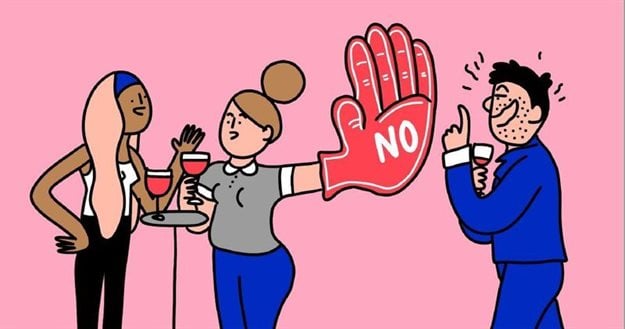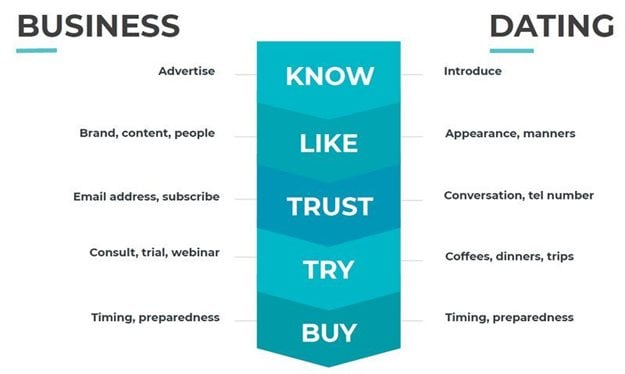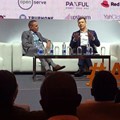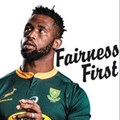#PR2020: Trends in the PR influencer, recruitment, reputation and measurement space

Nadia Hearn, director of Faselis and Get Published, is passionate about enabling brands and taking them to the next level.
Hearn explained that Faselis is a global PR platform, offering innovative solutions intended to support the industry with a platform that delivers key learnings on: innovation, especially how new tools and tech can move your business and clients forward.
It also highlights PR trends, to ensure your PR team remains relevant and competitive; and industry insights, offering a deeper look at markets, consumer behaviour and digital trends.

Trend 1: Connecting PR to lead generation, by Robin Tindall of Lead Genius
In deciding on his conference topic, Tindall shared that he had realised marketing was a key factor in his own career success, and many are in the dark on how exactly to convert marketing to sales today and win at this new ‘dating game’.
Tindall spoke of how overwhelming it can be to have to navigate the various features out there when making a purchase decision today, and how marketers need to keep that in mind.
The four-stage customer journey of today…
Tindall said every single transaction and interaction is part of the overall customer journey, and that menus today are especially difficult to navigate. Despite this, customers want simplicity.

If the choices are overly confusing, we simply opt-out and don’t buy any of the options as we buy what we understand, not necessarily what we need.
As marketing professionals, we need to understand this journey as well as that of our customers’ customer, so that we inject our messages in a way that simplifies the journey.
Tindall said it was John Jantsch of Duct Tape Marketing invented the marketing hourglass and explained the initial stages of the customer journey as ‘Problem’, ‘Know’, ‘Like’ and ‘Trust’.

The first stage is that of the problem we need solved, then we need to know a potential service provider or problem solver exists in the ‘know’ or advertising phase.
Next is the ‘like’ phase. There needs to be resonance here, as there’s an intangible component in play. This is followed by the ‘trust’ phase, and whether you want to use the provider.
Tindall acknowledged that this seems like quite a few steps, but as consumers, we do go through this with every interaction with the brand, often without realising it. Some stages take years, and sometimes we skip stages altogether.

In the dating environment, we listen to a ‘no’, but in the brand-customer relationship, we keep trying to get the consumer to say ‘yes’.
Tindall said the ‘know’ phase is the bridge between knowing the brand exists and bridging a connection with it.
Tindall said the Old Spice ‘The Man Your Man Could Smell Like’ ads were incredibly successful in this regard.
On the emotional connection front, there’s laughter as the ads made a connection in bridging the problem of men not smelling good. Humour works well in this case as consumers embraced the messages.

Speaking to the entrepreneurs in the room, Tindall said that South Africa’s economic future will be built on their shoulders.
The PR world needs to embrace and rethink the business model so that it’s attainable for the entrepreneur. That’s why he said the 'know' phase is often just a social media ad that shows your business exists as a way to solve consumers’ problems, and gives consumers an opportunity to like them.
On the entrepreneurial touchpoints needed to enforce that, Tindall said we need to be clear on our targets and what will make consumers like our brands. Much of that is based on content, which is where PR comes to play while the consumer is in the researching phase.
The final phase is that of 'trust'. After the consumer has given us signals that they have fallen in love, they are ready to engage with the brand.
In a dating set-up, Tindall says you know you have the trust of the person you’d like to have a relationship with when they continue a conversation with you to the neglect of the group they came with, or when they give you their phone number.
That doesn’t mean you should jump right in, though.
While it’s tempting to phone them up immediately and say “Let’s get married,” this is not the path a typical relationship follows, yet it’s what we often do in business – we try to sell as soon as we have the contact details. Instead, we need to work on that relationship and consolidate that trust, by providing content that shows we know what we are doing.This includes blog posts and emails and in measured through the subscribes as well as email opt-ins, opens and replies. Tindall says the golden rule here is to give and guide, not take and ask.
From a PR point of view, Tindall says you are effectively the company wingman. Marketing is therefore about getting someone to know, like and trust the brand, with PR a tool to do so.

Once you have the consumer’s trust, it’s time for the final steps of the customer journey: Try and buy, which hopefully lead to repeat and refer.
That’s why Tindall says to pace out your PR message so it’s in sync with what the client is trying to do from a marketing perspective, and ensure there isn’t a disconnect between marketing and PR.
Tindall says the ‘try’ phase is the most critical, as clients get to see if we can actually do what we have been preaching we can do. We, therefore, need to support what the marketing team is doing with trial offers, seminars, webinars, low-cost offers and other content.
That’s what will move the relationship forward to the ‘buying’ phase.
The purchase is generally the end game, so it’s down to the timing, to knowing when is just the right time for the sales team to get down on one knee and propose. Done correctly, the customer journey will look more like this:

Tindall concluded:
Don’t be the hero in the customer’s story, be the guide. You don’t want to be their Luke Skywalker, you want to be their Obi-Wan Kenobi.Trend 2: Managing reputations in the fluid digital age, by Regine Le Roux of Reputation Matters

Le Roux was introduced as a corporate reputation specialist who developed the Repudometer, a health check for the fitness of your company reputation.
Chances are you have invested significantly into your business digital footprint, but is it enough? Le Roux first asked, ‘What does reputation mean to you?’ Typical answers cover crisis management and social media mentions, but Le Roux says that consistency is key.
“You are either consistently good or consistently bad, either way, you are building a reputation for yourself.”
While it won’t really boost your personal health to only run around the block once every few weeks, you similarly need to measure your corporate reputation often.
The first question to ask is a health check: ‘How fit is your reputation and what do you base it on?’ Le Roux said it’s well-known in the industry that Advertising Value Equivalence or AVE isn’t necessarily the best measure.
Often, PR and earned media coverage is not valued often enough. The PR industry has a direct voice to the C-suite, but if you’re not speaking their language, you can forget about making an impact.
Le Roux said that balance is also critical. It doesn’t help to only focus on one area. Sticking with the personal health analogy, she said that cross-training is a good idea as the fitter you are, the less likely you are to injure yourself. It’s the same with reputation management.
If you have to manage a crisis, the pawpaw has already hit the fan. Rather prevent the pawpaw from getting anywhere close to the fan.But that means knowing how to build the reputation for your own company or for the brands you are looking after and understanding the different dimensions of a reputation.
Le Roux says the first step is to prove ourselves and build reputation through strategic intent. This is about more than business jargon. You need to know what to send out into the market place and be clear on the company values. These also need to form part of regular internal discussion.
This means your business vision and values need to be clear, as knowing where you are going is the golden thread that needs to be woven into all your communication.
Second to this is corporate governance and “how we do things around here.” It’s the standard operating procedures (SOP) and recruitment policy, as well as whether your leaders lead by example or not. They need to walk the talk and resonate with the company’s values.
Third, if your employees aren’t on the same page, you’re heading for disaster. You need to have those conversations internally, to share the company’s values and vision internally.
What is your unique selling point or USP? Can you describe your company or client’s business in just eight words? More than this, will the receptionist and the intern’s eight words resonate with yours?
Do you have the right people doing the right work in the right way?Le Roux says to make sure you have an effective recruitment process in place, to hire the right people for the job.
Next, it’s all good and well to have an amazing team in place, but you also need to give them the tools they need to do the job – millennials in the workplace crave knowledge, so this means asking what the growth plan and job spec looks like.
Le Roux reminds us that the business's finances also impact how the business is seen in the marketplace. Potential customers don’t usually look at the business balance sheet or income statement before making a decision, but it is a perception and reality that is communicated internally. So ask how transparent and ethical the organisation is with its finances.
Le Roux says the next important building block is the brand positioning. This is about who we do business with and whether they resonate with our values. Do you even know what their values are?
Often, we get the most value from CSI but this shouldn’t only be done when there is a crisis. Your company’s corporate social responsibility plan needs to be sustainable. Does it link to your business values and vision?
CSI shouldn’t be about randomly planting trees or helping out at an animal shelter. Look for ecosystems that work with your business values.Now we look at the whole picture and ask what’s missing…
The channels are glued together by communication, so your employees need to become fluent on this internal dialogue of what the business stands for. That’s what then gets communicated externally, as we live in a digital world with constant interaction between customers and brands that give a hint of the company morale.

Le Roux says it’s the internal dialogue that tends to be missing. We don’t factor in what our employees are thinking and saying about the company, which leads to a communication gap. We also need to look at what different generations want from the company.
With all of this in place, we can ask the interesting, difficult, sticky questions. Being better aligned to the brand should impact on which clients we take on – the full exercise is on the Reputation Matters website.
Trend 3: PR recruitment trends and insights, how to build a team for 2020 by Sasha Knott, technical director of Job Crystal
Knott is passionate about mentorship and finding the right talent so your business grows.
She spoke of her experience in recruiting an employee via Gumtree – the good news was that she found someone who seemed to be suitably qualified, who could start the next day. The bad news was that what they initially thought was a marijuana possession charge was actually one of domestic violence.
That’s why following a formal recruitment process is crucial.
From her time recruiting PR professionals, Knott learned that the PR and recruitment industries are very alike.
She’s been retrenched three times over her career. She applied for 367 jobs in one week, so she knows just how frustrating the job search is, and wanted to change that.From the other end of the scale, she says she knows it’s just as difficult from the other side of the screen, when you have what feels like a thousand emails in your inbox at any given time.
But there’s a definite need to take better care of the job applicants that feel they get no feedback from countless applications.

Knott says that PR and marketing skills are definitely becoming more integrated, with technology impacting every industry, so more than ever before, “the stuff you measure is the stuff you manage.”
Finding the perfect employee
Honing in on the PR industry overall, roles available in the industry range from PR manager to PR social media officer, PR account director, internship, PR analyst, communications and PR officer, content account manager, PR officer, copywriter and PR co-ordinator.
Salaries range from R5k/month for interns to between R20k and R85k/month for PR officers, with the best salaries in Gauteng, KwaZulu-Natal and Western Cape.
Knott also shared interesting insights relating to PR and recruitment trends specific to Cape Town.
Cape Town has three of the top universities in Africa, and is the sixth most affordable city, compared to other global tech cities, and has the lowest unemployment rate in South Africa.Data shows that it takes 33 hours on average to find one good employee and that it can cost a business up to R250k to hire the wrong person.
Knott also shared three actions to find the best talent:

When deciding where to start, Knott said to be consistent and to start with your business social and personal networks as you have ownership of these, so can search them continuously. Also, do your research and advertise on job portals, as that’s where candidates are already looking.
You can drill this down by size, specific industry, type of clients and area. Recruiters who specialise per industry do well, as they have a better understanding of the specific job requirements.
You can also look at specific sourcers, but they often contact suitable experienced candidates on LinkedIn only to find they’re not actively looking to find a new job, which means you may need to negotiate.
Are you actively attracting the right talent?
Unfortunately, the information and content found on a business portal or website is usually a few years old, whereas your social media will show what you did yesterday, so this is a better source of information on the company for job seekers.
Knott also mentioned that a personality and culture fit is usually what places the candidate, as CVs often don’t tell the full story. But you still need a professional CV to get your foot in the door.
Ideally, recruiters should reply to each applicant and provide a reason why they were not deemed to be a good fit, but this is a difficult process – as explained at the recent Gartner Symposium, Amazon’s AI recruitment tool processed the CVs or resumes of the people the company had already hired and was asked to ‘find similar’.
Unfortunately, the program was found to not be accepting female applicants’ resumes – gender bias had mistakenly entered the process, so while a good idea in concept, many lost trust in the process and the program was scrapped.
Trend 4: Future of influencers and market insight trends for 2020, by Jody Kolbee of Writers Hand Studios, in partnership with Get-Published
Following a lunch break, we heard from Kolbee, who spoke of the rise of influencers in the PR space, many of whom have a different online personality to their real-life personality.
Not all are Jacks or Jills of All Trades, either – some are good at content generation, some are only after freebies, so be careful who you choose to represent your brand.
Kolbee added that millennials and fluid thinking have reshaped the world, with 19-year-old beauty YouTuber James Charles recently appointed as the first male face of CoverGirl.
But it’s not all smooth sailing as influencers can also damage your brand, especially those who are powered by personality and where they are leveraged against each other.
Kolbee shared the story of how beauty influencers James Charles himself, as well as Tati Westbrook and Jeffree Star are currently feuding, which has led to what he calls “one hot PR mess”, where 6m followers were lost…
Kolbee said this serves as a warning to be careful which PR influencers you associate with. Choosing the ‘top ones’ means differentiating between micro-influencers, with their specific targets and niche markets. “How else can I break, divide and conquer my audience?”
In the organic makeup market, Kolbee says you would look to target vegans and vegetarians, as well as the people who buy similar brands and who else they are following.You need to understand what they are buying and who they are following to find your pocket in the niche, to understand the ‘why’ before the ‘how’.

To do so, Kolbee says to follow the three Rs when choosing an influencer for your marketing campaigns:
- Relevance: Just because they shape awesome content, doesn’t mean that content is a fit for the brand, especially if it doesn’t echo the brand sentiment. We need to ask if they’re already posting relevant content that aligns with your business, and pairs well with the brand.
- Reach: How many people will you reach in the influencer’s network? You can have a thousand likes on a post, but are they from the right people and do they go on to buy the product? How will the post engagement grow conversion? Most SA companies only really care about the bottom line and don’t focus on building the brand journey.
- Resonance: This is the level of engagement the influencer can create with their audience and should be your ‘why’ before starting the campaign journey. Kolbee says resonance will be especially important in 2020, as we look beyond a large follower base to find out why consumers like their content.
What to look out for when working with influencers
The reality is that we all have a checklist. There are lots of ‘fluff’ influencers out there, just doing things for the likes. We need to ask whether all of their content is honest, and rather aim to build brand trust with niche influencers:

Kolbee says this discussion goes beyond the influencers’ control as they become mini celebs, like James Charles now walking the Met Gala red carpet despite not being an actor!
Kolbee recommends the approach of finding niche and micro-influencers to drive engagement, as they also run polls and share your content in their Facebook and Instagram Stories, which is now the “mother of branding”.
Keep in mind that you’re looking to drive conversions, not just likes. Was there a call-to-action or a contact form in the influencer’s social media posting, or was it just to raise awareness? Was there any form of relationship-building in the post?
Kolbee added that you can also use automated tools to discover, select and connect with the right influencers for your brand and niche marketing campaigns, like Trend Kite, Buzzsumo and Hypr as these include built-in automation and insights, but the influencer needs to buy into your brand first as you need to build the relationship organically.
After all, PR is about building perspective and perception to gain consumers’ trust.
But how do we fund this? Kolbee said we tend to get excited about the wrong numbers. Just because someone clicked on the ad, doesn’t mean they converted. Kolbee also mentioned that ‘pay per post’ will cost an arm and a leg with top influencers.
The four best practices that can be applied when calculating the remuneration of an influencer, which will both be fair to the influencers and help manage your campaign’s financial strategy, are:
- Cost-Per-Click or Cost-Per-Engagement: This is when you compensate influencers according to the number of engagements they drive with their content.
- Pay-Per-Post: With this model, you pay influencers a fixed amount for each post they create for your business.
- Free products/experiences: Instead of, or in addition to, monetary compensation, you can offer influencers free products or experiences in exchange for their partnership. Kolbee said the trade exchange route, work well if your brand is new and doesn’t yet have credibility. You can offer the influencer a unique affiliate code, which means you can track their specific referrals rather than try prove the results retroactively.
- Cost-Per-Acquisition: Also known as “cost per conversion” or “cost per action,” which means you compensate influencers for the number of actions or acquisitions they drive.
Tips for working with influencers in 2020
Kolbee shared the following as tried and tested social media campaign strategies that work well with when paired up with influencer campaigns. Some of them may work for your brand, and others may need more out-of-the-box thinking...
- Ask the influencer to create a Storefront in their Instagram bio. Instagram doesn’t easily allow all users and pages to include links in posts. Storefronts will solve this.
- Competitions work well, as the influencer shapes the story around the product. When an influencer hosts a giveaway contest using your products, they get a chance to engage their followers, while at the same time driving engagement for your business, as incentivisation is a big driver of customer relationship management or CRM.
- Creating new content now means relying on the influencer to do so. You gain their followers, so they need to be seen as authentically creating the content themselves, so trust them to tell your story in their own voice.
Sharing action points on how to effectively apply these learnings, Kolbee said to act fast, as you have the balance of December to work with influencers - their summer campaign strategies start now and your brand can leverage off of their events and hashtags that will be the season’s hit.
By New Year’s Eve, everyone will be full of YOLO and New Year’s resolutions – #summerbody is already starting to trends, so it’s too late to only start shaping your 2020 content in January.
Start working on your relevance, reach and resonance now.
Kolbee also says to use effective influencer management tools, because if you can’t measure it you can’t manage it. Also, make an effort to learn the skills and the lingo.
Kolbee also shared insights around video content, which is everywhere right now. He said that 60-second video only works when you’re trying to increase the Story with the brand – 10-second content is too short for this, whereas 30-seconds is the magic middle.
Kolbee also reminded attendees that Facebook launched new rules from 1 November, so if a page posts too frequently that content won’t be shown as frequently on follower feeds as it comes across as spam. They’re also being stricter on using ‘#ad’ as the first hashtag in your post if it’s sponsored.
The digital world evolves very quickly. If you don’t evolve with it, soon you won’t get to sit at the table.
Trend 5: Update on quantifiable PR reporting, measurement and media exposure tracking for ROI by Jaco Pienaar of Pear SA
PEAR stands for ‘Professional Evaluation And Research’, and chief knowledge officer Pienaar shared strategic approaches to perception management with attendees across media monitoring, media measurement and media strategy.

Pienaar said that when it comes to media measurement, PR often sees analysis as a grudge purchase, but it’s crucial for proper campaign results. We need to understand the process as a full cycle, as you can’t properly measure without the correct data, which then needs to be reported on.
As communications professional, you are most likely reporting to an Exco that doesn’t fully understand what you do and the activity that leads up to getting an article published.But everything starts with the question ‘Why’…
Pienaar says if we don’t know what we are measuring and why we are doing so, we won’t know what media services we need to measure. Often, the full-on approach is requested even if the campaign only ran in one medium, which can lead to the problem of trying to drill down through too much noise.
Pienaar added that it’s not something new in this day and age to have an internal measurement and monitoring function, or to outsource it, but to have this done correctly, you need to ensure you know what is being measured, especially in the world of hashtags, in order to become savvy with keyword logic.
There’s also a discrepancy between audited figures and rate card figures.
While quantity is usually the main goal, the qualitative aspect is where you’ll derive the meaning behind the coverage, beyond the numbers.Pienaar said you need to understand who you are reporting to so that your findings resonate. Most clients just want a few pages of data, with visuals.
If you can’t properly communicate that, your efforts fall flat. That said, the implementation is the ‘so what’. We know the results and what they mean, but how does that then guide and impact the campaign overall?

Pienaar says to take the time to debrief and understand what worked and what didn’t, so that you make the right decisions going forward.
From a systems-thinking perspective, Pienaar says to remember that everything is connected and needs to work at full efficiency for the cycle to be efficient. There are so many globalised sources and opportunities to get a message out there today, beyond the traditional journalist basis.
But whichever media point you approach, you need to know that you can’t measure them all the same way.
You just can’t measure a weekly newspaper’s readership against the likes from an Instagram influencer’s posts. There is no one-size-fits-all approach, and broadcast remains the most powerful and influential media, due to literacy rates and access.
Pienaar said that an experienced public relations professional will have most likely built up the relationship with the old-school media, but may struggle to get to grips with the new media. From the measurement side, this has the implication that the content will be categorised.
Pienaar also touched on the importance of learning from your competitors’ media coverage, and from scenario planning and keeping an eye on the forecasting space, because:
Often, what can go wrong, will go wrong.So your brand needs to understand what can go wrong and how to mitigate potential disasters by understanding the impact of the content.
From a strategy side, Pienaar says to ask “What is the narrative and what does it report on?” It’s not just about meeting targets, but also who you’re working with and reporting to, as no two clients are alike.
It’s critical to understand your audience, as it comprises so many different people, each of which can understand the same experience in various ways.
Factoring in generational differences, Pienaar says to understand that the younger generation wants visuals, and to see the data represented in different ways.
Saying ‘now what’ and looking at the next steps, Pienaar says to ask what are the lessons learned and how does this impact the entire cycle? How does intellectual capital develop? How are the partners impacted by the campaign?
This includes reputational capital, and means keeping in mind that the client and the PR agency staff are also consumers of the media, so if your messaging is disingenuous, they will see this.
You need to practice what you preach and if you can’t answer the ‘now what’ based on your media coverage received, something has fallen flat.
Pienaar says to follow through and make decisions to help your brand move forward.
He demonstrated the Rugby World Cup’s “Stronger together” campaign and winning trophy tour as an example:
Speaking of the countrywide trophy tour and why it’s important to measure an event like this, Pienaar asked how it benefits countrywide sentiment, apart from giving government a reason to boast.
Pienaar said if you put different hats on you realise that consumer brands can also latch onto this, if done properly, such as with the Takealot TV special – they had their finger on the pulse and created positive buzz.
Sponsors like MTN would have also loved this type of coverage, while the trophy tour became a form of competition municipally, in seeing how well the tour was received, as a sign of regional loyalty.
Pienaar said it’s important for brands to have a finger on the pulse of what’s happening and what’s important culturally, like the current gender-based violence (GBV) coverage.
Pienaar says to watch for consistency in the media narrative, and make a genuine comment.
You need to understand what’s happening around you and why they’re happening, as a huge national event like the rugby trophy tour would explain why other client coverage falls to the wayside, especially when it comes to earned media.
Pienaar spoke of Nando’s as winning in this regard, with their recent Mzanzipoli ad:
Nando’s ads don’t expressly sell chicken – instead, the brand understands what to poke fun at and what to stay away from, which has become a very clever communications strategy.
This results in lots of coverage as there’s lots to latch onto. Going online is an obvious move, as there’s limited – and expensive – traditional media space.
Pienaar concluded that it’s important to be very specific with your keywords and campaign so that they’re easy to measure.
















































